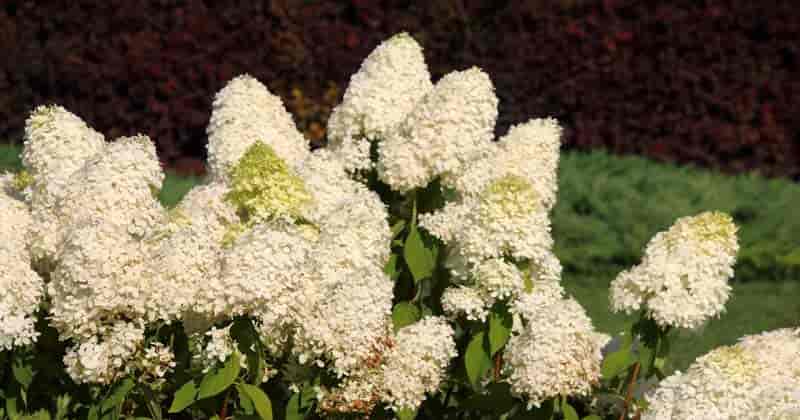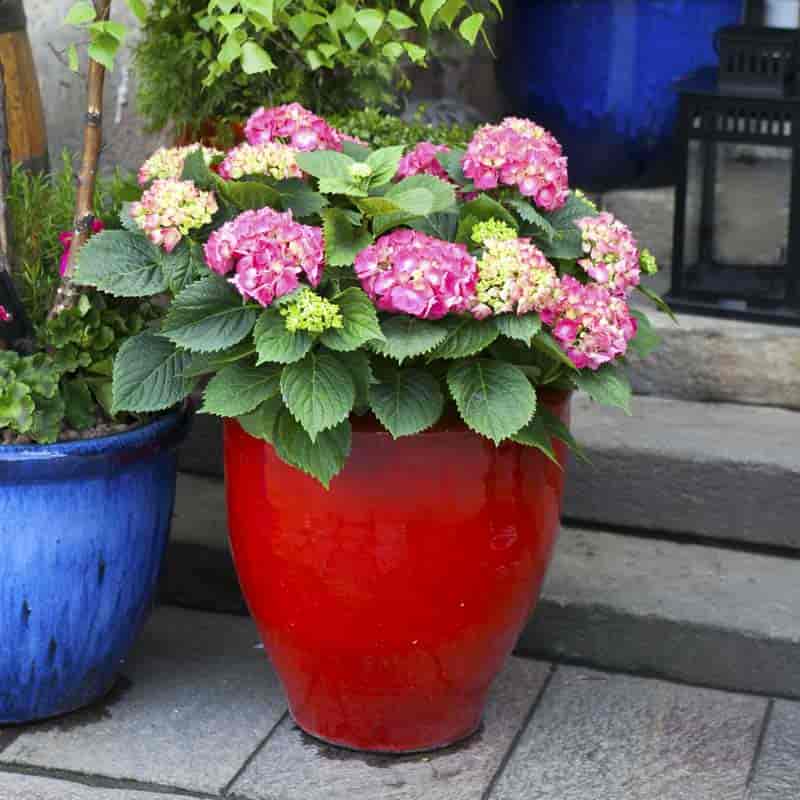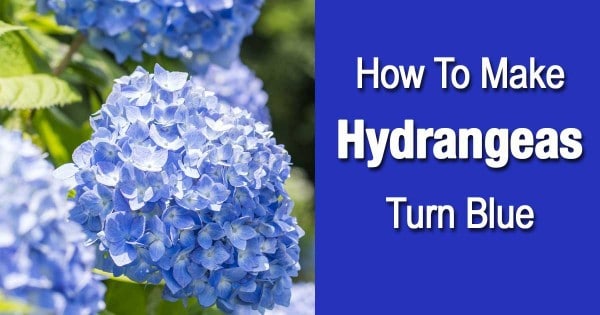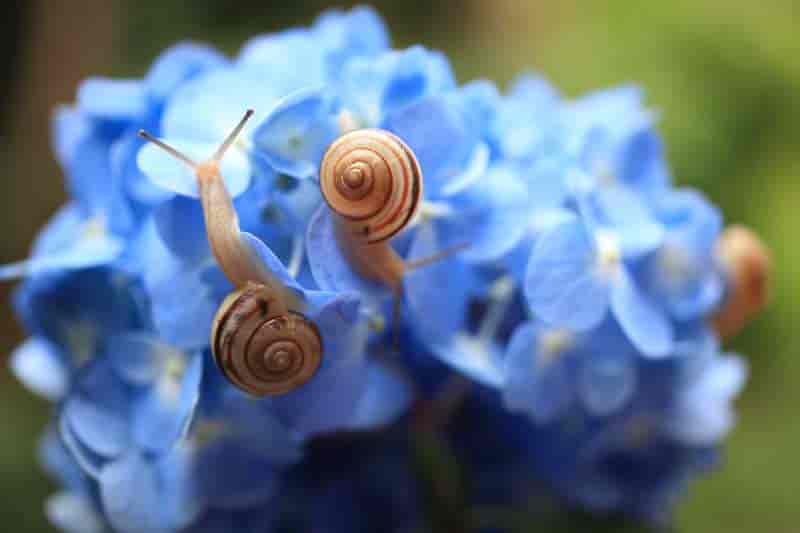Hydrangeas are easy to grow, beautiful, hardy garden shrubs that add color and texture to your landscape.
Available in a wide variety of bloom colors in shades of white, pink, lavender and blue (often blooming on a single plant, it’s no wonder these plants are among the most popular choices in the home landscape.
Top Varieties and Tools For Hydrangea Care
- Endless Summer Hydrangea
- PeeGee Hydrangea
- Felco Hand Pruners
- Root Hormone Rooting Powder
They make wonderful individual specimens grown in containers and put on a spectacular show in borders and group plantings from mid-summer to late in the fall.
In this article, we will describe several of the most popular cultivars and explain how to care for them correctly. Read on to learn more.
Types of Hydrangeas
There are about two dozen different types of hydrangeas, but only about half a dozen are widely available in the United States. These choices can be divided into two categories.
The first category is made up of plants that will bloom on stems from the current season (new growth). The second category is made up of plants that only bloom on established, woody stem (growth from the previous year).
As you will soon learn there are two flower types of hydrangeas – the mophead and the lacecap.
What’s The Difference Between a Lacecap or Mophead Hydrangea?
The most popular type is mophead. Showy and loved for their voluptuous softball size blooms, filling the landscape with head-turning pink, white and blue flowers.
The flower heads of lacecap hydrangeas have more of a dome shape but stunning just the same as they call butterflies and bees for a visit.
Hydrangea Category #1 – Plants Blooming On Current Season Growth
These types of hydrangeas form buds on current year growth in the early summer. Hydrangea blooms reliably and profusely year-after-year even in very cold climates. Here are three of the most reliable, top-performers:
Panicle hydrangeas (paniculata)
These plants hail from Asia and are hardy in the USDA hardiness zones 3 through 7. The plants can grow to reach fifteen feet high and produce abundant, cone-shaped panicles of creamy white blossoms. The panicles range in size from six to eighteen inches long.
The most popular cultivar is Panicle Grandiflora (aka P.G. or PeeGee Hydrangea). These plants grow very easily, making them an excellent and satisfying choice for beginning gardeners. They do well in a mixed border, planted as a hedge or pruned to grow as a tree.
Another popular cultivar is the dwarf Little Quick Fire Hydrangea.
 Smooth hydrangeas (arborescens)
Smooth hydrangeas (arborescens)
This variety is hardy from USDA hardiness zones 3 through 9.
It does very well when planted in cold climates, and it is sometimes nicknamed “Snowballs” both because of its cold resistance and its large, showy white blossom clusters.
The most common cultivar of Hydrangea arborescens is ‘Annabelle,’ produces clusters of white blossoms that can measure one foot across.
As the blooms age, they take on a greenish hue.
French Hydrangea (macrophylla) or Hydrangea serrata
This plant is a small, subspecies that presents a delicate appearance. The leaves and flowers of these plants are a bit smaller than those of other varieties.
Flowers may grow in either lace-cap or mop-head formation and make excellent additions to dried flower arrangements. This variety does well planted as an under-story for large trees.
Hydrangea Category #2 – Plants Blooming On Previous Year Growth
These plants bloom on older, woody growth, so it is important that the old wood from the previous season survive through late winter. For this reason, choose from these varieties only if you live in an area with mild winters. Here are three excellent choices:
Oakleaf hydrangea (quercifolia)
This variety is a US native found growing wild in the woodlands of the southeastern United States.
These medium-sized shrubs grow to between six and eight feet high and produce panicles of white, creamy blooms ranging from four to twelve inches long.
These plants are bud-hardy to zone 5.
Oakleaf hydrangea is so-called because of its interestingly shaped leaves, which put on a lovely show of color in the autumn.
The blooms also go through an impressive color transformation and often turn an intense shade of rose or brown during the fall months.
After the leaves have fallen, in fall, the textured bark and dried blooms add winter interest. The most popular oak-leaf cultivars are:
- Alice
- Snowflake
- Snow Queen
Known as the French hydrangea, like the Mountain hydrangea, the big leaf variety also comes in two flower shapes. Choose from mophead or lacehead.
The mophead Hydrangea variety is Hortensia, (Hydrangea macrophylla var. macrophylla).
This native of Japan is hardy to zone 6. It blooms early in the summer, producing showy balls in bloom color shades of white, pink and blue. Some of the best choices are:
- All Summer Beauty
- Nikko Blue
Lacecap hydrangea varieties (Hydrangea macrophylla var. normalis) are cold hardy from USDA hardiness zones 5 to zone 9. The plant produces flat-topped, lacy flower clusters made up of a circle of tiny, fertile flowers surrounded by a ring of larger, showy blooms.
Both mop-head and lace-cap varieties grow to be four to six feet tall. They make an excellent choice for mass planting, borders or on their own as specimen plants. Blue Wave is one of the most popular of the lacecap Hydrangea choices.
Climbing hydrangea (anomala or petiolaris)
An interesting and impressive plant, rugged and hardy from USDA zones 4 to zone 7. While they do take a while to become established, once started, they can be a bit hard to stop as they climb and spread to heights and widths in excess of eighty feet.
These plants do well in a wide variety of light conditions ranging from shade to full sun. Blossoms appear in mid-summer and are lace-capped in creamy white. Leaves are dark, glossy and attractive.
The vines can leave a sticky residue on the surfaces to which they cling. For this reason, you may prefer to have your plant climb a trellis, rock-pile, tree or fence rather than having it climb your house. [source]
How To Take Care Of Hydrangeas
As with most plants, lightly moist, well-drained soil is best. A location with full morning sun and afternoon shade is usually preferable. This is especially true in very hot climates.
A hydrangea bed set on the north side of a house or outbuilding is generally successful, especially for smooth, oakleaf and bigleaf hydrangeas. Deep shade will stunt flowering. Partial shade is acceptable for mountain and big-leaf varieties.
Some types of hydrangeas, the panicle, and climbing varieties, for example, can do well with more sun. When selecting a location for your plants, factor in:
- The type of plant
- Your climate
- Your hydrangea watering schedule
If your climate is very hot, your plants will naturally need a bit more shade and a bit more water.
Tips for Planting Hydrangeas
- Plant in the autumn or springtime.
- Provide ample growing space by setting your plants three-to-ten feet apart.
- Provide ample root space by digging a hole that is two or three times wider than the root ball and equal in depth.
- Add plenty of finished compost and organic matter to the soil to enrich and lighten it.
- To plant, set your young hydrangea into the prepared hole. Fill the hole halfway with soil and then water thoroughly. Once all water has drained, add enough soil to fill up the hole and water again.
Hydrangea Care Tips
- During the first year, take care to keep your plants well-watered. Dry soil will cause leaves to wilt.
- Fertilize with discretion. Very rich soil may not need fertilizer. Sandy, light soil will require a dose of Hydrangea fertilizer late winter or early in the spring. Excessive fertilizing will result in lots of leaves and few blooms.
- In very cold climates prepare the plant for winter by applying a thick layer (18 inches) of organic mulch and protecting with a chicken wire or snow fence cage filled with loose leaves. Avoid using maple leaves because they deteriorate very rapidly and will not last through the winter.
Growing Hydrangeas in Tubs
 If you have little or no yard but still want to enjoy a hydrangea on your deck or patio, you can have success planting in tubs or large containers. The Endless Summer hydrangea is an excellent variety for this purpose in terms of size and flower color choices.
If you have little or no yard but still want to enjoy a hydrangea on your deck or patio, you can have success planting in tubs or large containers. The Endless Summer hydrangea is an excellent variety for this purpose in terms of size and flower color choices.
This compact variety comes in purple, rosy pink and white. It makes a great standalone specimen plant, or you can add companion plants to make an attractive mini-garden.
When planting hydrangeas in containers, be sure to use potting soil or a prepared container mix. It’s best if you can get a mix that comes ready-made with a slow-release fertilizer. If not, be sure to add a good fertilizer with a 10-30-10 NPK ratio.
Plant as you would any other container plant with light, irregular stones (e.g., lava rock) or Styrofoam peanuts or chunks in the bottom of the container for good drainage.
Add soil up to the top of the plant’s root ball and firm it into place. Take care not to fill the container all the way to the top. Leave about three inches of space to facilitate efficient watering.
When watering your plants, fill the pot to the rim and allow the water to soak thoroughly into the soil and run out the drainage holes (very important) in the bottom of the pot. The goal – keep the soil evenly moist but not soggy.
Hydrangeas need ample water because they are, ideally, supporting copious numbers of big, beautiful blooms. Check the soil regularly and provide water when it feels dry. This is especially important when the weather is windy and hot.
Can You Keep Hydrangeas in Pots Over Winter?
According to gardening expert, Melinda Myers it is difficult and undesirable to over-winter hydrangeas in pots indoors.
Instead, if you have a potted or container hydrangea you wish keep in the pot for winter, sink the container in the ground to protect the roots and protect the plant with a cage of leaves if your climate is very cold.
Alternately, you may want to move the plant into an unheated outbuilding or a sheltered location and surround it with straw bales or bags of leaves to protect it from the cold. Check the soil from time to time and provide a small drink if the soil is dry.
When keeping hydrangeas in pots for the winter, don’t cut back the stem and leaves. Just let them stand. This will help the plant develop hardiness. When spring arrives, prune back any dead wood.
Pay close attention to the type of plant you have. If it is a variety that only blooms on old wood, don’t prune harshly. If it is a variety that blooms on new growth, you do not need to be quite so careful.
Pruning
Pruning hydrangeas can be very confusing as so much depends on the type of hydrangea in question. Here are some guidelines to help you sort out the right method for your plants.
Old Growth Hydrangea Bloomers
Once established, smooth, oakleaf, bigleaf and panicle varieties may need a bit of regular pruning. To do this, using a pair of hand pruners like these Felco #2 you would remove approximately a third of the oldest stem annually. This will help the bush stay healthy and present a fuller appearance.
Perform this pruning during the winter months when the leaves have fallen because you will have an easier time seeing what you are pruning and reaching into the plant to access inner stems. You may wish to cut back a few of the oldest stems all the way to the ground to encourage fullness and branching.
Also, keep your eyes open for dead and cold damaged stem and leaves. Remove these regardless of the season.
In the early spring, if you notice your plant has new growth at ground level but also bare stem, remove those stems. They are dead.
If you have a mophead variety, leave the blooms over winter and trim them off in the springtime when new leaves begin to emerge. Cut back to the first set of healthy buds. The dead/dry blooms add winter interest to your landscape.
For old, damaged or neglected plants it is often a good idea to start over from “ground-zero.” Cut and prune the plant all the way back to the ground in late autumn after any blossoms have faded. You may not have Hydrangea flowers the first season after this drastic pruning, but the health and the flowering of the plant will greatly improve in subsequent seasons.
New Growth Bloomers
Prune varieties that bloom on new season growth at any time after the plant finished blooming and gone dormant. You can prune back dead branches late in the fall or during the late winter or very early spring before new buds and growth appears. After the first flowering, you may want to perform a light pruning to encourage a second flowering.
The University of Massachusetts Amherst has a handy pruning chart here.
How Do I Get My Hydrangea to Bloom?
One of the main reasons hydrangeas don’t bloom is improper plant selection. When you choose your plant, be sure that it will be bud-hardy in your setting. If you live in a very cold climate, you may be best off selecting a variety that blooms on new growth. Otherwise, buds may be killed off in the winter leaving you with a plant only producing leaves and no blooms.
Another problem is improper setting. If your plants are in an area of deep shade, you will not get many (or any) blooms. Make sure your bushes will get at least four hours of good full sun daily.
Pruning incorrectly can also cause a reduction of blossoms. For varieties blooming on old wood, pruning at the wrong time of year could result in pruning off the next year’s flower buds. This would naturally lead to a flower head with fewer blooms in the coming season.
Weather conditions that damage buds can also lead to reduced flowering. Early fall freezes occurring before the plant goes into dormancy can be damaging, as can extremely cold winter temperatures and unexpected cold snaps in the springtime after the plant comes out of dormancy.
To protect your plants from cold damage, prepare them for winter as described above. In the springtime, check the weather forecast frequently and cover your plants with sheets or blankets to protect them from damage caused by sudden cold snaps.
How To Propagate Hydrangeas
Hydrangeas grow easily from cuttings or using a method called layering. Here are some simple instructions for two common methods of propagation.
How to Grow Hydrangeas from Cuttings
- Start with a cutting approximately five or six inches long taken from a branch that does not have blossoms.
- Trim off the lower two sets of leaves to expose the leaf nodes. Roots will grow from these.
- Trim large leaves to half their original size.
- Dust cutting ends with a rooting hormone (recommended).
- Poke the cuttings into a sterile planting medium or damp vermiculite.
- Water thoroughly and allow the potting medium to drain. It should be lightly moist-not soggy.
- Place a couple of stakes opposite one-another on the outer edges of the pot.
- Cover the pot with a plastic bag. The stakes should support the bag and prevent it from touching the cuttings.
- Place the pot in a warm area with bright, indirect morning sun.
- Check the soil periodically and water lightly, only when it feels dry.
Roots should form within a couple of weeks. This will happen faster in warmer weather and with higher humidity levels.
How to Grow Hydrangeas with Ground Layering
- Choose a branch that grows low to the ground. Leave it attached to the parent plant.
- Trim off the leaves to about six inches above the ground, revealing the leaf nodes.
- Scrape a little bark off the side of the branch facing out. This will come in contact with the ground. There should also be at least one leaf node on this side of the branch.
- Dig a trench approximately two inches deep and coax the branch into it.
- Cover the branch with soil and/or compost.
- Set a stone or brick on the buried branch so it will stay put.
- Water enough to keep the soil lightly moist, not soggy. The brick or rock will hold moisture in place, so don’t overdo it.
- When roots have formed (2-3 weeks) sever the branch from the parent plant.
- Dig up your new plant and put it in a pot or new location in your yard or garden.
 [source]
[source]
Changing Flower Colors
The colors of some varieties of hydrangeas can be changed by manipulating the pH of the soil. Doing this affects aluminum ion availability. A very acidic soil pH level lower than 5.5, some types of hydrangeas will produce blue flowers. An alkaline soil with a soil pH level higher than 5.5, should produce pink blooms.
It is important to note that this only works with varieties that were pink or blue to start with. If your plant produces white blooms, they will stay white no matter what!
 For more information, see our articles:
For more information, see our articles:
- Blue Hydrangea: How to Make Hydrangeas Turn Blue
- Troubles: Hydrangea Will Not Flower
Common Pests and Problems
These hardy plants have very few problems with pests and diseases if properly planted and cared for in an outdoor setting. Just as with any other plant, if the wrong variety is planted, the wrong location chosen or the soil stays soggy, the plants will be more susceptible to illnesses and pests. Those most commonly seen include:
- Powdery mildew
- Ring-spot virus
- Leaf spots
- Gray mold
- Slugs
- Rust
Mold and Mildew Problems
Powdery mildew fungus is the main problem for big-leaf varieties, and it happens most frequently if plants are grown in very humid conditions and/or in deep shade.
If your plants are infested with powdery mildew, you will notice a pale, gray dusty coating on the leaves. You may also see some purple splotches. This condition will not kill your plants, but it’s unattractive. Maintaining a healthy environment with enough sun, good air circulation, and light, well-drained soil will help prevent it.
Powdery mildew is not the only fungal infection to affect this plant. There are also a number of leaf spot organisms that can cause gray or brown lesions on the leaves. These may be surrounded by a circle of purple fungi. Just as with powdery mildew, these problems can be avoided and controlled with good care.
Root rot can be a problem for any plant kept in excessively wet conditions. It is especially problematic for oakleaf varieties. The common variety of root rot is Armillaria, which will cause plants to wilt suddenly and die. Be sure to plant hydrangeas in light, airy, well-drained soil and avoid over-watering. [source]
Rust is a problem that affects them from time-to-time. It manifests as orangish/brown spots on the backs of leaves. If you rub the spots, they will turn to dust which is the fungal spores. You usually see this toward the end of autumn just before the leaves fall. It is not usually deadly or even problematic.
Pests
Oakleaf varieties may be targeted by Japanese beetles, but they usually do not appear in great numbers. You can pick them off and drop them into a bucket of soapy water or dust or spray your plants with an insecticide; however, this is usually not necessary.
Infestations of aphids may take up residence on any variety early in the spring when leaves are tender.
If you notice ants on your plants, turn the leaves over and you are sure to see aphids on the undersides and stem of the plants.
Ants eat aphids’ excretions (honeydew) and have been observed managing aphid “herds” as if they were livestock.
Give your plants a good blast with insecticidal soap to knock aphids and ants off and prevent their return.
As the season progresses and leaves toughen up, they will not be as attractive to aphids.
During periods of drought, spider mites can be a problem. These microscopic critters are attracted to new growth because they like to suck the moisture out of it during times when water is scarce.
If you notice new growth wilting, or if you see webbing between new leaves, you can be sure you have a mite infestation. To deal with this, prune off the affected foliage and give your plants a good watering. Keep them watered to prevent mite infestation.
Slugs enjoy all kinds of green, leafy veggies including hydrangeas. To prevent and control their predation you can use a variety of methods, including:
- Water early in the morning so that your plants will be dry at night when slugs are active.
- Set up beer traps to attract them and drown them.
- Use a flashlight and tweezers to pick them off at night.
- Use an iron phosphate slug bait for large areas.
- Surround your plants with copper strips to repel slugs and snails. In the garden, Diatomaceous earth helps control slugs, snails and a variety of other pests.
 More On: How to Control Snails & Slugs in Your Garden
More On: How to Control Snails & Slugs in Your Garden
Soil Related Problems
If the soil pH level is too high, bigleaf hydrangea may suffer from iron chlorosis.
When this happens, new leaves will turn yellow and die. To correct this problem, add chelated iron to the soil. This product is easy to find at your local garden center or online.
Be sure to read and follow packaging directions carefully to correct the problem in the short term. In the long term, you should correct the soil conditions by adding aluminum sulfate and/or mulching with pine bark or other acidic materials to lower the soil pH levels.
Also, Courtenay over at “The Creek Line House” shares her experience with Reviving a sad looking Hydrangea using baking soda.
Hydrangea As Cut Flowers
Fresh, cut hydrangea flowers don’t typically do well. To avoid problems with fresh hydrangea cuttings wilting, be sure to cut your blooms early in the day while it is cool.
Avoid clipping very young blooms. Mature flowers keep better. Get them into water immediately and hope for the best. Even if you are very careful, you may find that your fresh hydrangea arrangement doesn’t survive more than an hour or so.
Traditionally, hydrangea flowers are used in dry flower arrangements. To do this, wait until the flower heads are mature and have taken on a papery texture. They should be nearly dry on the bush. Gather the hydrangea flowers on a still, dry day.
Remove all of the leaves from the stem and hang the blooms upside-down, individually in a dark, dry, warm, airy location. Don’t hang them in bunches or they will stick together and dry with flat, squashed spots.
Allow them to dry for at least two weeks before making wreaths, flower arrangements and the like. If you want to enhance or change the color of the blooms, spray them lightly with a diluted mixture of Rit dye.
If you plan on creating lots of interesting dried hydrangea decorations, you may want to seek out varieties that naturally present interesting colors. Big-leaf varieties offer the most variation with blooms in shades of green, blue, purple, violet and rose.
Where To Buy Hydrangeas
Your local garden center will surely keep some hydrangeas in stock, but their selection may be limited. Remember to check the cold hardiness of any plant you are considering to be sure that it will really do well in your area.
To be certain of getting plants that are suited to your climate, check with local garden clubs and/or attend local plant sales. If you notice an attractive hydrangea thriving in your neighborhood, befriend its owner and ask for cuttings!
To locate unusual cultivars, check local and online specialty nurseries to find just the right plants to beautify your landscape.
Other plants from the family Hydrangeaceae:
- The evergreen shrub Carpenteria Californica




